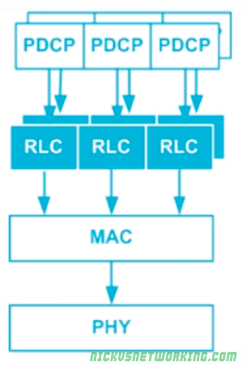These are my lecture notes from IMT’s NET02x (4G Network Essentials) course, I thought I’d post them here as they may be useful to someone. You can find my complete notes here.
The Packet Data Convergence Protocol PDCP protocol stack sits ontop of the radio interface stack, and manages the connection the EPC.

There is one PDCP per RLC instance, except when operating in Transparent Mode.
Functionality offered by PDCP
Header Compression
Using Robust Header Correction (ROHC) PDCP compresses the headers.
As the traffic is point to point headers vary vary little so is predictable and can be compressed efficiently.
For a VoLTE medea stream a 40 byte IPv6 header, 8 byte UDP header, 12 byte RTP header and 30 bytes of RTP data.
This means that we have 60 bytes of headers and only 30 bytes of data, which is a very inefficient use of resources, so by compressing this data we can shrink this substantially.
Handover Mitigation
When handing over between NodeBs on previous 3GPP RANs packet loss and reordering was common during handovers between NodeBs.
E-UTRAN specs have minimized this as much as possible, the handing off eNB can transfer information using PDCP about data to be transferred to the UE to the eNB the UE is handing over too.
Security
As the radio link is particularly vulnerable to eavesdropping, PDCP offers another independent ciphering and integrity control mechanism to verify data is not modified / intercepted.
Usage of PDCP Functionality
Not all these functionalities are used for all types of traffic, as shown in the table below.

Recap of Radio Interfaces

PDCP is discussed in this post, interfacing the radio interface with the core network.
RLC is discussed here and manages re-sequencing of data, offers 3 modes of QoS and performs segmentation and concatenation of traffic.
MAC is discussed here and performs multiplexing of the logical channels, HARQ, Radio Resource Allocation.
Physical Channel is discussed here and performs coding for error correction and modulates the data onto the Air (Uu) interface via FDD or TDD.
Data Hierarchy
A summary of the hierarchy is shown here with user data in pink and control data in blue:

The RNTI is shown in a dotted box as the RNTI is not transmitted as a header on the transport block but is logically associated with the transport block thanks to the allocation table.
Abbreviation Index
